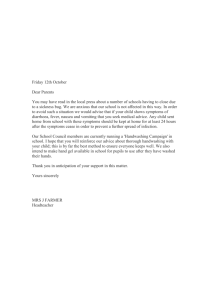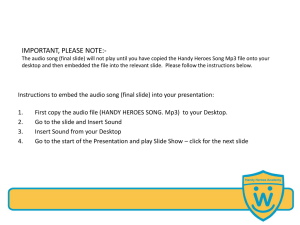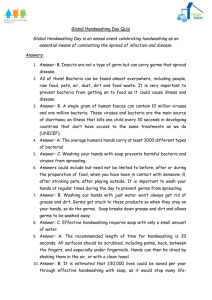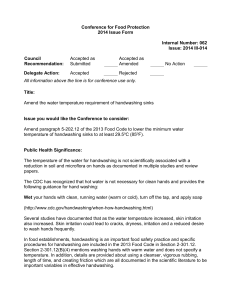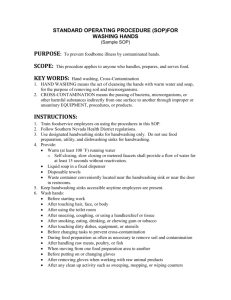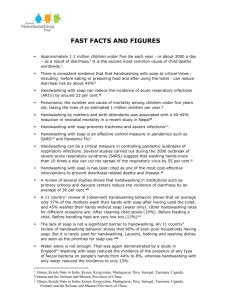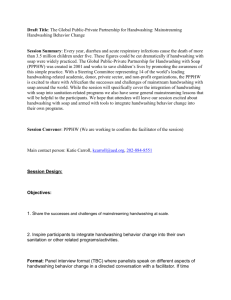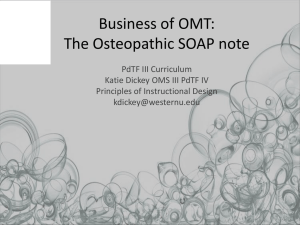Fast Facts: Water, Sanitation and Hygiene
advertisement
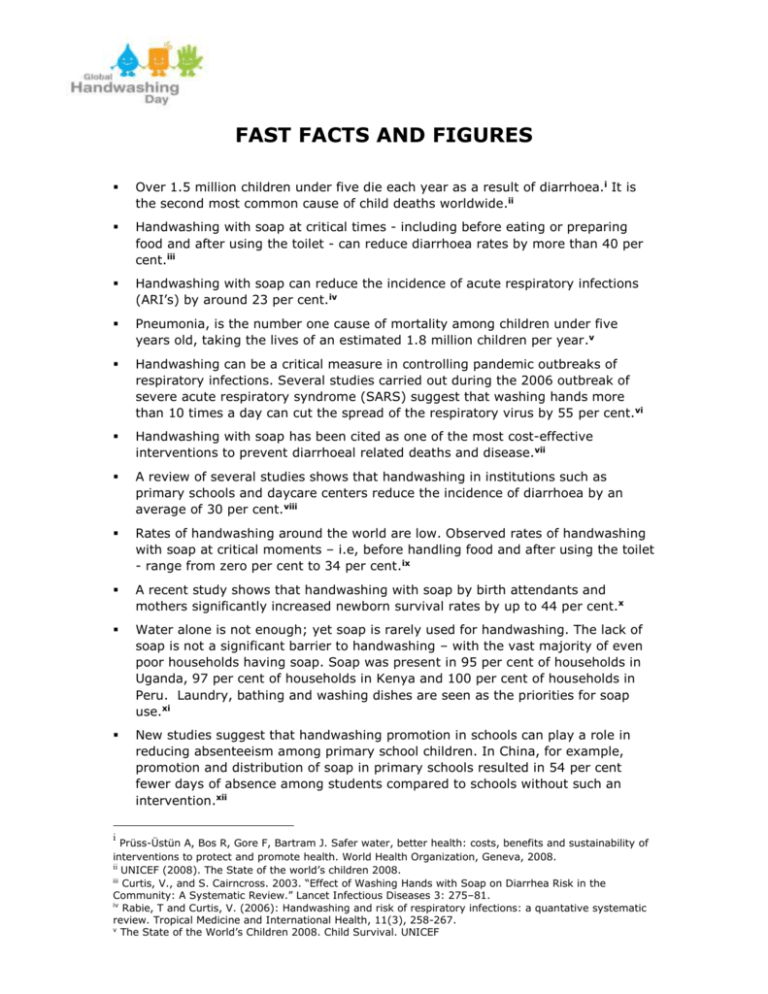
FAST FACTS AND FIGURES Over 1.5 million children under five die each year as a result of diarrhoea.i It is the second most common cause of child deaths worldwide.ii Handwashing with soap at critical times - including before eating or preparing food and after using the toilet - can reduce diarrhoea rates by more than 40 per cent.iii Handwashing with soap can reduce the incidence of acute respiratory infections (ARI’s) by around 23 per cent.iv Pneumonia, is the number one cause of mortality among children under five years old, taking the lives of an estimated 1.8 million children per year.v Handwashing can be a critical measure in controlling pandemic outbreaks of respiratory infections. Several studies carried out during the 2006 outbreak of severe acute respiratory syndrome (SARS) suggest that washing hands more than 10 times a day can cut the spread of the respiratory virus by 55 per cent.vi Handwashing with soap has been cited as one of the most cost-effective interventions to prevent diarrhoeal related deaths and disease.vii A review of several studies shows that handwashing in institutions such as primary schools and daycare centers reduce the incidence of diarrhoea by an average of 30 per cent.viii Rates of handwashing around the world are low. Observed rates of handwashing with soap at critical moments – i.e, before handling food and after using the toilet - range from zero per cent to 34 per cent.ix A recent study shows that handwashing with soap by birth attendants and mothers significantly increased newborn survival rates by up to 44 per cent.x Water alone is not enough; yet soap is rarely used for handwashing. The lack of soap is not a significant barrier to handwashing – with the vast majority of even poor households having soap. Soap was present in 95 per cent of households in Uganda, 97 per cent of households in Kenya and 100 per cent of households in Peru. Laundry, bathing and washing dishes are seen as the priorities for soap use.xi New studies suggest that handwashing promotion in schools can play a role in reducing absenteeism among primary school children. In China, for example, promotion and distribution of soap in primary schools resulted in 54 per cent fewer days of absence among students compared to schools without such an intervention.xii i Prüss-Üstün A, Bos R, Gore F, Bartram J. Safer water, better health: costs, benefits and sustainability of interventions to protect and promote health. World Health Organization, Geneva, 2008. ii UNICEF (2008). The State of the world’s children 2008. iii Curtis, V., and S. Cairncross. 2003. “Effect of Washing Hands with Soap on Diarrhea Risk in the Community: A Systematic Review.” Lancet Infectious Diseases 3: 275–81. iv Rabie, T and Curtis, V. (2006): Handwashing and risk of respiratory infections: a quantative systematic review. Tropical Medicine and International Health, 11(3), 258-267. v The State of the World’s Children 2008. Child Survival. UNICEF Tom Jefferson, Chris Del Mar, Liz Dooley, Eliana Ferroni, Lubna A Al-Ansary, Ghada A Bawazeer, Mieke L van Driel, Ruth Foxlee, Alessandro Rivetti. (2009). Physical interventions to interrupt or reduce the spread of respiratory viruses: systematic review. BMJ 2009;339:b3675, doi: 10.1136/bmj.b3675 (Published 22 September 2009) vii Cairncross, S. Valdmanis V. 2006. Water supply, sanitation and hygiene promotion. Chapter 41. In. Disease Control Priorities in Developing Countries. Second Edition. Edt. Jameson et al 2006. The World Bank. Washington DC: National Institutes of Health. viii Cochrane 2008 - Ejemot RI, Ehiri JE, Meremikwu MM, Critchley JA. Hand washing for preventing diarrhoea. Cochrane Database of Systematic Reviews 2008, Issue 1. Art. No.: CD004265. DOI: 10.1002/14651858.CD004265.pub2. ix Scott B, Curtis V & Rabie, T. 2003. Protecting children from diarrhoea and acute respiratory infections: the role of handwashing promotion in water and sanitation programmes. WHO Regional Health Forum 7, 42–47 x Victor Rhee; Luke C. Mullany; Subarna K. Khatry; Joanne Katz; Steven C. LeClerq; Gary L. Darmstadt; James M. Tielsch. Maternal and Birth Attendant.Hand Washing and Neonatal Mortality in Southern Nepal Arch Pediatr AdolescMed. 2008;162(7):603-608. xi Second Planners guide – pg. 41 xii Bowen et al 2007. A cluster-randomized controlled trial evaluating the effect of a handwashingpromotion program in Chinese primary schools. am. j. trop. med. hyg., 76(6), 2007, pp. 1166–1173 vi
